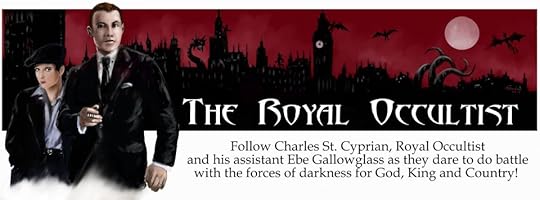Gentlemen Adventurers
Today’s look at the history of the office of the Royal Occultist focuses on the decades leading up to the Great War, and the exploits of Beamish, Drood and Carnacki.
Aylmer Beamish’s time in office was a turbulent one. He opposed numerous horrors in his time, including the Creeping Man, Indrid Cold, the Black Rabbits of the Peathraichean Raidan and the infernal Sebastian Melmoth. He also purchased the house on Cheyne Walk that was to become the official residence of future Royal Occultists, ostensibly on the advice of a ghost.
In 1878, Beamish confronted a resurgent Order of the Cosmic Ram, and made the acquaintance of one of their junior members, Sir Edwin Drood. Scientist, philosopher and extrasensory talent, Drood was a modern renaissance man with a reputation for investigation into the paranormal. It is unknown why he agreed to become Beamish’s assistant, given his obvious distaste for the dissolute occultist. All that is known for certain is that the two men cemented their alliance during an investigation into a series of unnatural events surrounding the Woolwich Pier Disaster.
The partnership between the two men lasted for close to a decade until Beamish’s disappearance beneath the streets of London. Drood’s assumption of the duties of the Royal Occultist brought a return to respectability in the eyes of many – especially Drood’s former compatriots in the Order of the Cosmic Ram. Unfortunately for them, Drood showed little interest in serving old masters. Instead, he turned his attentions to codifying and extending his remit, forming links between his office and those of similar organisations, including the London Tunnel Authority.
During his tenure, Drood made great strides in recording and cataloguing his various encounters with what he called the ‘ab-natural’, including his encounter with the vampiric invader calling himself Dracula and the malign tulpa known as Hyde. Drood also anonymously disseminated that information to the public through the works of friendly writers such as Robert Louis Stevenson and Bram Stoker.
He was an early patron of the Society for Psychical Research, the London Spiritualist Alliance, the Ghost Club and a dozen others, working alongside notables such as Sir Arthur Conan Doyle and AA Watts. It was through these societies that he came into contact with the young occultist, Thomas Carnacki.
Carnacki quickly proved himself indispensable, aiding Drood in his investigations at the close of Victoria’s reign. It was due to Carnacki that fictionalised versions of Drood’s exploits filled the pages of several popular periodicals, though Drood himself disapproved of what he viewed as sensationalism. Regardless, the two men worked well together, and Carnacki soon learned all that Drood had to teach him.
But like his mentor Beamish, Drood vanished at the close of the nineteenth century. Drood had become withdrawn and taciturn in the months prior to his disappearance, as if burdened by some great secret. It is said he secreted himself in a garret in Soho, taking no visitors for several days before eventually vanishing without a trace from the locked room, leaving behind only a set of cryptic notes and a curious jewel of unknown provenance. Carnacki made some attempt to learn what had happened to his teacher, but was eventually forced to give up his quest and turn his attentions to taking up the duties of the Royal Occultist.
Thanks largely to Drood’s foresight, Carnacki’s early tenure was largely uneventful. His investigations into the ab-natural were many and varied, and he continued his associations with the London Tunnel Authority and the Esoteric Investigative Service. The latter was to see its own remit expand during this period, thanks to the tacit support of Carnacki himself, as well as Home Secretary Churchill and other influential figures in the Asquith Government.
By 1912, the EIS had become the Ministry of Esoteric Observation and Containment. What Carnacki thought of this change has not been recorded, though it is known that relations between the office of the Royal Occultist and the Ministry cooled noticeably in this period. It is also during this period that Carnacki became associated with the man who was to become his assistant – Charles St. Cyprian…




